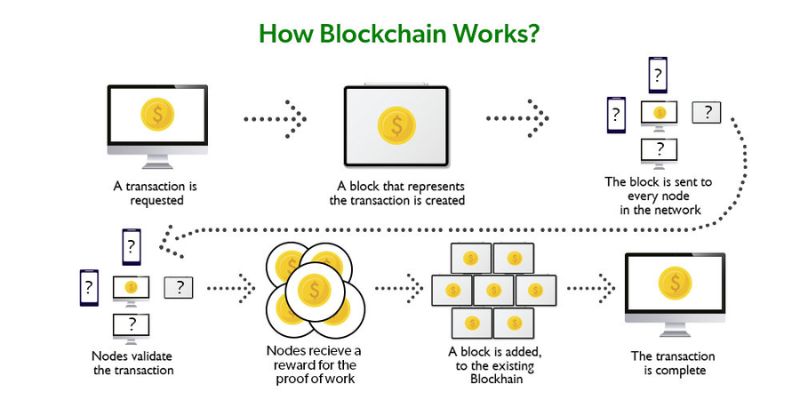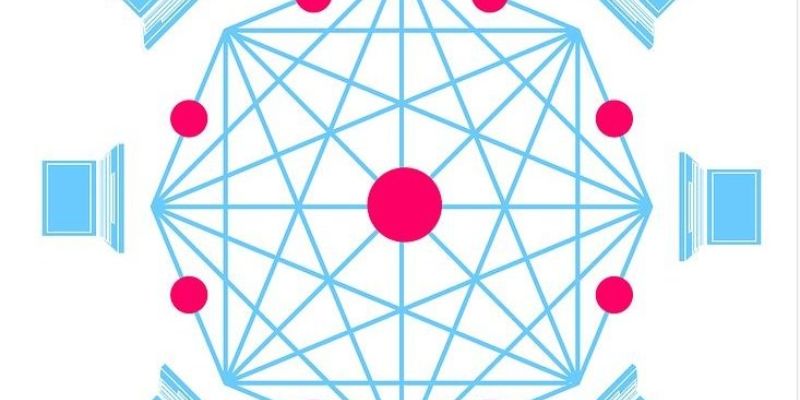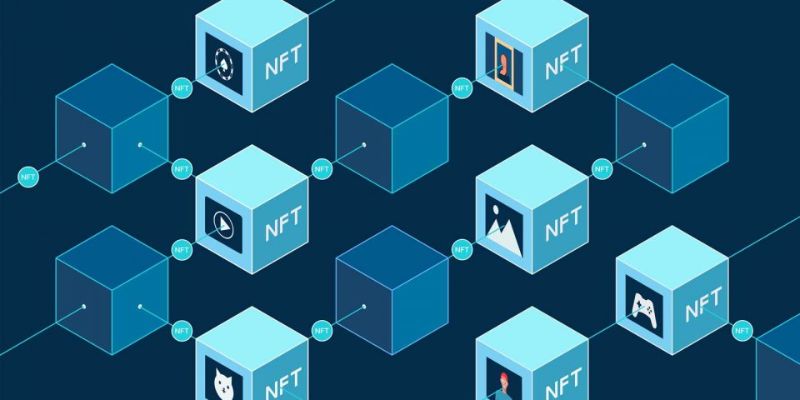Blockchain Simplified: Unlocking the Basics Behind the Tech Buzz
Let’s cut through the noise and get right to it: blockchain. You’ve heard the term thrown around, and it might seem wrapped in complexity. But here, we’re going to break down a basic explanation of how blockchain works, clear and simple. It’s a fresh way to store and share data that’s so secure, it’s like having a bank vault online. If you’ve ever wondered how this tech keeps things like digital money or contracts safe, I’ve got you covered. Think of blockchain as a digital ledger that everyone checks, but no one owns. Imagine a record book that’s copied across thousands of computers, each entry sealed in digital stone. That’s the blockchain, the backbone of a new kind of internet. Buckle up and let’s unpack this modern marvel together.
Demystifying the Technology: What is Blockchain?
Understanding Blockchain Technology
Blockchain is like a digital ledger book. It keeps records safe so no one can cheat. Everyone has a copy of this book, making it hard to mess with the info inside. It’s a way to share info and make sure it’s right.
Blockchain Fundamentals
Let’s break it down in simple steps. Imagine you’re playing a game where you trade cards. Every time someone trades, we all write it down. We have to agree on every trade. This way, no one can say they have a card they don’t.
The game with the cards is like what we call ‘distributed ledger basics’. It’s a bunch of computers that all have the same ‘ledger’, or record book. It’s spread out, not just in one place.
‘Blockchain for beginners’ means we’re looking at this cool tech in easy ways. We want everyone to get it. With blockchain, each trade is a ‘block’ in a chain of trades. We make sure each block is legit before adding it to the chain.
These blocks are super safe because of ‘cryptographic hash function’. This is a fancy way of turning info into a secret code. This code is unique like a fingerprint. No two are the same.
When talking about ‘how blockchain secures data’, think locks on a treasure chest. It’s got special ways to keep data safe, so bad guys can’t grab it.
The cool thing is, blockchain works on ‘principles of blockchain’. These principles are a set of rules that make sure everything is fair and works right. It’s like the rulebook we all follow in our card game.
For example, ‘what is a blockchain node?’ A node is like a player in our game. It’s a computer that helps keep the blockchain running right. Each node double-checks the blocks to keep the chain honest.
‘Understanding blocks in blockchain’ means knowing how each trade becomes part of the game. We write down the trade, make sure it’s true, then lock it in as a part of the story.
During a ‘blockchain transaction process’, someone gives a card, it’s written down, it’s checked, and then it’s locked in. Simple, right?
Blockchains can be different kinds. ‘Blockchain networks explained’ is about understanding the different types of games we could play. Some are open to anyone, some are just for a few friends.
‘Immutability in blockchain’ is a big word for ‘cannot change’. Once we write down a trade, it’s set in stone. You can’t go back and say you didn’t trade that shiny card.
In the end, ‘decentralized consensus mechanism’ is how we all agree on a trade. No boss tells us what’s what. We all have a say, making it super fair.
‘Peer-to-peer technology’ means we’re all equal players. We don’t need a big boss to play. We just need our cards and our rulebook.
You might have heard of ‘proof of work vs proof of stake’. These are different ways we can agree on trades. Some ways need a lot of work, like checking all the trades yourself. Others let you play based on how many cards you have.
‘Public vs private blockchain’ is like the difference between a playground anyone can visit versus your backyard where only your friends can come in.
Each game needs a ‘block validation process’. That’s making sure each trade is following the rules before it goes in the book.
‘Benefits of blockchain technology’ are really cool. It’s honest, fair, and no one can cheat. Plus, it’s really hard to lose any info about the trades.
‘Smart contracts basics’ are like deals we make that happen by themselves. If I say you can have my card when you give me five marbles, the game makes sure it happens.
“Blockchain ledger comparison” is like looking at different game rule books to see which one you like best. Every game has its own way to keep score.
In our game, the ‘role of miners in blockchain’ are like helpers who check the trades. They work hard to make sure every trade is good.
When we ask, “how do blockchain transactions work?” we’re talking about giving and getting cards. It’s the give and take in our game.
Finally, ‘blockchain confirmation process’ means we all agree that the trade is done right. Everyone sees it, double-checks it, and says, “yes, that happened.”
‘Blockchain security features’ are all the ways we keep our game safe from cheaters. It’s like having a really good lock on the box where we keep our cards.
With ‘hashing and blockchain’, we take the details of a trade, turn it into a secret code, and that’s how we remember it. No one can change it.
The ‘blockchain verification method’ is how we check if a trade was fair. It’s like asking everyone, “Did you see that? Was it okay?”
You’ve got ‘tokenization on the blockchain’ which is like turning something real, like a bike, into a card so we can trade it in our game.
‘Blockchain network participants’ are the players. They make the game work by playing and following the rules.
The way we set up our game is the ‘blockchain data structure’. It’s like having a big box where we store all the cards in order.
‘Blockchain encryption methods’ keep our trades secret and safe. It’s like whispering a secret that only your friend can hear.
Each round in the game, ‘block creation in blockchain’, is like adding a new page to our record book. Every trade gets a new page.
‘Digital signatures in blockchain’ are like putting your name on a paper saying you agree. It shows everyone you’re good for your trade.
Understanding ‘blockchain anonymity’ means even though we play the game, no one has to know our real names. We can just be players.
‘Blockchain for data integrity’ is all about keeping the info true and unbroken. Just like we want our card trades to be honest.
Finally, ‘how blockchain handles data’ is how our game moves info around. It keeps it safe and sound while we play.
Under the Hood: How Blockchain Functions
Distributed Ledger Basics
Imagine a book filled with all the stuff folks trade – kind of like a diary. This book is open for anyone to see. That’s what we call a distributed ledger. A ledger is a record of trades, like giving a toy for candy. Each trade is a block in the chain. So we call it a blockchain. Want to add a new trade? You gotta follow rules. Only when everyone agrees, the trade goes in the book.
It’s not just one book either. It’s lots of copies, all the same, spread out over many computers. This means no sneaky changes. You change one, you gotta change them all, and that’s super tough to do. That’s what makes this ledger special. It’s everywhere, and it’s safe.
Cryptographic Hash Function
Now let’s get fancy with a word – cryptographic hash function. Think of it like a secret code for each trade. It turns info into a jumble of letters and numbers. Every trade’s code is unique. If even one thing changes, the code totally changes too.
So why is this cool? Well, it makes our blockchain super tough to mess with. If someone tries to change a trade, the secret code won’t match up anymore. And since every block’s code is linked to the last one, one wrong code spoils the whole chain.
But here’s another neat part. You can’t look at the code and figure out the trade. It’s one-way, like a locked door that only opens from inside. That keeps your stuff private. Smart, right?
So, just remember, blockchain keeps your trades safe and sound. It uses this ledger that’s copied all over and locks each trade with a secret code. Easy-peasy, but also super strong. Now you’re in on the secret of how blockchain works!
Securing the Chain: The Role of Nodes and Networks
What is a Blockchain Node?
Let’s tackle a big question: what is a blockchain node? It’s a computer that is part of a blockchain network. This computer has a job as important as a guard. It follows rules to check and share data. It keeps a copy of all the shared data on the blockchain. This is a part of the blockchain’s power to keep data safe and sound. Nodes talk to each other, making sure they all agree on the current data.
Blockchain Security Features
You might wonder, how does blockchain keep our data safe? Well, it uses some neat tricks. First, all data is locked down with something called a hash. Think of it like a secret code that’s super hard to crack. To change data, you need the secret codes and the nod from many nodes. That’s a tough job for anyone sneaky.
Blockchains are also built on trust. But not just any trust – the kind that doesn’t need a big boss. Each computer on the network checks the work of others. This is called consensus, and it’s like a group promise to keep everything above board.
We use peer-to-peer tech in blockchain, which means everyone talks directly, no middlemen. This way, data zips around fast and direct. And with proof of work or proof of stake, we make sure adding new data isn’t easy or cheap. This stops bad folks from messing with the system.
Not all blockchains are open for everyone, though. Some are public, like a city park. Others are private, like your own backyard. They all have their own rules for how new blocks of data can show up.
And when it comes to smart contracts, think of them as robot deals. They only go through if everyone follows the rules laid out from the start. This saves time and helps avoid any mix-ups or broken promises.
So, nodes are crucial for keeping things running smoothly. They check and pass along each bit of data. The whole process is clear, and everyone involved can see what’s going on. That’s what makes blockchain so trustworthy and why it’s getting popular in many parts of our lives.
Understanding blockchain nodes and security helps you see why this tech is super handy today. It gives us a new way to agree on things digitally, without doubting if it’s done right. With blockchain, we build trust with tech, making our digital world a bit more reliable.
Real-World Applications: Blockchain in Action
Smart Contracts Basics
Think of a smart contract like a vending machine. You pick a snack, pay, and the machine gives it to you. No shopkeeper needed! Smart contracts on blockchain work similarly. They are self-executing contracts. They have rules written in code on the blockchain. When the rules are met, the contract does its job automatically.
Benefits of Blockchain Technology
Blockchain has changed how we trust and exchange things. It’s like a game where every player keeps score. Everyone can check it, so no one can cheat. Blockchains store records across a network. This network is like a team where everyone has a job. They work together and keep everything secure.
Understanding blockchain technology helps see why it’s special. It secures data really well. It does this using a chain of blocks. Each block has a cryptographic hash. Think of it as a unique lock. This lock links to the previous block, making a chain. It’s super hard to change any data once in the chain. This is called immutability.
Blockchain transaction process is another cool part. When someone wants to make a transaction, the network checks it. This is like asking the whole team if the play was fair. Once they agree, the transaction joins the blockchain. The check and approval process is called decentralized consensus.
Let’s explore blockchain networks explained simply. They can be public or private, like a park or a backyard party. Public networks let anyone join, while private ones have a guest list. In these networks, there’s a block validation process. Think of it as a puzzle. Miners solve this to add a new block.
Proof of work vs proof of stake are two ways to solve the puzzle. Proof of work is like a race to solve it first. Proof of stake chooses someone based on how many coins they have. Both ways help keep the blockchain running well.
Now, how do blockchain transactions work? Imagine you want to send a digital coin to a friend. You start the process, and the network checks it using everyone’s scorecards. Once it’s approved, your friend gets the coin. This is the blockchain confirmation process.
In summary, blockchain has many benefits. It’s trustable because it’s tough to change any data. It’s efficient as it cuts out the middleman. Plus, it’s secure, thanks to clever math and teamwork. This makes blockchain a big deal for how we do things in the future. It offers a new way to agree on things without needing someone in charge to say it’s okay. This is very handy for all sorts of uses, from money to keeping records. Thanks to blockchain, we can look forward to a world where deals are safer, faster, and fair for all.
In this post, we’ve uncovered the power of blockchain technology. We started by explaining what blockchain is and why it’s a game-changer. Then, we dived into how it works, from the shared ledgers to the complex hash functions that keep our data safe. We also looked at nodes and networks, the heroes that guard the blockchain against attacks.
Lastly, we explored real-world uses, like smart contracts, and how this tech makes things safer and faster. My final take? Blockchain isn’t just for tech wizards — it’s shaping our future and it’s here to stay. Keep an eye on it; it’s sure to change how we handle our business and personal data.
Q&A :
What is blockchain technology and how does it function?
Blockchain technology is a digital ledger system that is decentralized and distributed across a network of computers. This ensures that all transactions are recorded in a secure and unalterable way. When a transaction occurs, it is grouped with other transactions to form a block. Each block is then chained to the previous one using cryptographic principles, hence the term “blockchain.” This process provides transparency and security, making it virtually impossible to alter any single record without altering subsequent blocks and being detected by the network.
Can you explain the basic structure of a blockchain?
The basic structure of a blockchain consists of a sequence of blocks, each containing transaction data, a timestamp, and a cryptographic hash of the previous block, creating a linked chain. The first block in the chain is called the genesis block. Every new block created involves a consensus mechanism, such as proof of work or proof of stake, to validate the transactions. This secure design ensures that each block is tamper-evident, adding to the robustness of the blockchain.
What are the key features that make blockchain secure?
The key features that contribute to blockchain’s security include decentralization, cryptographic hashing, and consensus mechanisms. Decentralization means no single entity has control over the entire network, making it resistant to fraud. Cryptographic hashing secures the integrity of transaction history within each block. Consensus mechanisms require network participants to agree on the validity of transactions before they are added to the block, which prevents unauthorized alterations.
How do transactions get verified in a blockchain?
Transactions on a blockchain are verified through a process called mining, for blockchains such as Bitcoin or Ethereum that use a Proof of Work (PoW) consensus. In PoW, miners compete to solve complex cryptographic puzzles, and the first to solve it gets the right to add the new block to the chain. For blockchains using Proof of Stake (PoS) or other consensus algorithms, transactions are validated by selected validators staking their cryptocurrency as collateral to endorse a new block. Successful verification results in new blocks being added to the chain and miners or validators being rewarded.
Why is blockchain considered transparent if it is secure and anonymous?
Blockchain is considered transparent because all transaction details are recorded on a public ledger, visible to anyone. This includes the transaction amount, timestamp, and the digital addresses of the involved parties. While details of the users behind the digital addresses remain anonymous, the transaction history and the movement of assets within the blockchain can be openly reviewed, leading to a high level of transparency without compromising individual privacy.


